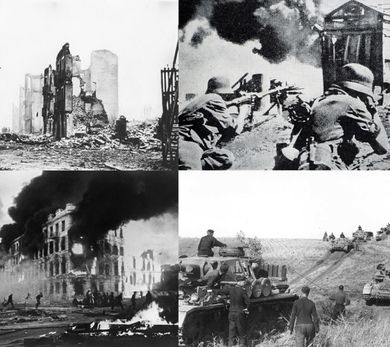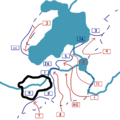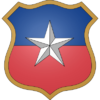Siege of San Salvador
The Siege of San Salvador (17 May 1946 – 30 August 1949), known in Creeperian Spanish as the Cerco de San Salvador, also called the Battle of San Salvador, (Batalla de San Salvador), was the largest, lengthiest, and deadliest confrontation of the Creeperian Civil War, in which the Catholic Imperial Restoration Council and the National Council for Peace and Order fought for control of the city of San Salvador, the capital city of Creeperopolis. The battle was not only confined to the department of San Salvador, but was also fought in Zapatista, San Luís, and the State of the Church. It was also the deadliest battle in Terraconserva history.
The Miguelist offensive to capture San Salvador began in May 1946. The attack was preceeded by the Miguelist Air Force bombing which reduced much of the city to rubble over the period of one week. The fighting degenerated into house-to-house fighting; both sides poured reinforcements into the city to prevent the other from gaining complete control. By 1948, 60% of the city had been reduced to rubble.
In June 1949, the Miguelists launched an offensive into western San Salvador which failed. The Romerists responded and launched their own offensive into the eastern parts of the city controlled by the Miguelists. The Miguelists began to fall apart and a retreat order was given. Romero II ordered a no-quarter on Miguelist prisoners of war. The Miguelists completely withdrew out of the San Salvador Valley on 30 August 1949. The siege lasted three years, three months, one week, and six days.
Contents
Background
Prelude
Order of battle
Miguelists
North-Lake San Salvador front
Army Group Mauricio Tasis Quesada – Field Marshal José Bolívar Aguirre
- 3rd Miguelist Army – General Rigoberto Fernán Tasis
- 9th Miguelist Army – General Ricardo Rosales Román
- 4th Terranilian Infantry Division – Major General Adam Gát
- 2nd Miguelist Flotilla – Admiral Lorenzo Sarmiento Elvira
- 15th Miguelist Air Force Wing – General Antonio Morterero Nores
East-central San Salvador front
Chief Field Marshal Juan Salinas Figueroa
Army Group Qarl Marx – Field Marshal Miguel Salinas Ortega
- 1st Miguelist Army – General Alan Hurtado Ros
- 11th Miguelist Army – General Rubén Alguacil Prats
- 28th Miguelist Air Force Wing – General Sebastián Pousa Frexia
- Miguelist National Guard – Chief Guard Ángel Moruga Leoz
- Atheist Red Army – General Mariano Alcocer Fraga
South-Volcano San Salvador front
Army Group Joel Lacasa Campos – Field Marshal Pascual Espinar Casaus
- 7th Miguelist Army – General Pedro Morillo Coronil
- 8th Miguelist Army – General Antonio Yon Sosa
- 27th Miguelist Air Force Wing – General Dídac Pareja Campos
Romerists
North-Lake San Salvador front
Army Group Miguel I – Field Marshal Juan Primavera Sánchez
- 3rd Romerist Army – General Agustín Sarmiento Cruz
- 17th Xussman Infantry Division – Colonel Roman Kassakov
- 11th Romerist Army – General Hector Carballo Lain
- 16th Romerist Flotilla – Admiral David Cortés Andino
- 3rd Romerist Air Force Wing – General Rolando Dávalos Abasto
- Falange Creeperiano – Captain Óscar Únzaga Vega
East-central San Salvador front
Chief Field Marshal Alfonso Cabañeras Moreno
Army Group Manuel III – Field Marshal Máximo Barrueco Morterero
- 1st Romerist Army – General Vicente Capmany Fraga
- 2nd Romerist Army – General Aaron Chicote Villa
- 4th Romerist Air Force Wing – General Pablo Piñón Ureña
- Romerist Imperial Guard – Chief Guard Gerardo Aguinaldo Villacrés
- Camisas Negras – Caudillo Carlos Hernández Videla
South-Volcano San Salvador front
Army Group Alfonso I – Field Marshal Jorge Díaz Molina
- 5th Romerist Army – General Miguel Saelices Cabal
- 3rd Lyoan Special Unit – Colonel Manima Lama
- 9th Romerist Army – General Xavier Dávalos Carita
- 7th Romerist Air Force Wing – General Aarón Tafalla Rubio
- Creeperian People's Catholic Front – General Alexander Sánchez Molina
- Militarist Nationalist Front – General Adolfo Rivera López
Siege
Bombing of San Salvador

On the evening of 17 May 1946, the Miguelist Air Force's 15th, 27th, and 28th Air Force Wings took off from airbases in Zapatista and flew over the city of San Salvador, the Romerist capital, to destroy fortifications and disorganize the Romerist garrison in the city in preparation for a Miguelist attack on the city. The goal was to capture the city, capture strategic air and naval bases, and shatter Romerist morale in an attempt to prolong the war and drain Romerist supplies and morale. The bombardment of the city began at approximately 10:27pm San Salvador Time. The 15th Air Force Wing was tasked with strategically bombing industrial complexes, military airports, and military ship yards along the Asambio, San Salvador, and Zapatista Rivers and along the coastlines of Lake San Salvador and Lake Zapatista to slow down Romerist manufacturing and production of armor and weapons. The 27th Air Force Wing was tasked with tactically bombing Romerist Army garrisons in the San Salvador department to hamper and delay an immediate Romerist response. The 28th Air Force Wing was ordered to attack civilian targets such as homes, schools, and specifically churches to destroy morale.
The bombing of the city endured from 17 May until 24 May, the following week. In that time, the Romerists responded by mobilizing their 1st, 2nd, 3rd, 5th, 9th, and 11th Armies to defend the city from the Miguelist forces.
The Holy city of San Salvador shall never fall to the forces of evil. Evil will be eradicated from this city, from the Fatherland, and the planet.
The Romerists also engaged the 3rd, 4th, and 7th Air Force Wings to retaliate against the Miguelist bombings and to alleviate the city from bombardment.
Occupation of the east


Beginning on 24 May 1946, the National Council for Peace and Order initiated Operation Yucca to capture a significant portion of the city of San Salvador. The 1st Army, 11th Army, and National Guard advanced north along the Zapatista River with the 1st and 11th Armies making a river crossing of the San Salvador River. The 7th and 8th Armies advanced north too with the 7th Army threatening the borders of the State of the Church once more following the end of the Papal War and the 8th Army pushing to the shores of the San Salvador River. The 9th Army pushed north from the opposite side of the Asambio River and Lake Zapatista and pushed north along the shores of Lake San Salvador in the department of San Luís. The 3rd Army pushed south out of San Salvador del Norte into San Salvador down along the coast of Lake San Salvador.
The Miguelist Navy's 2nd Flotilla consisting of one battleship, three heavy cruisers, six light cruisers, two destroyers, and four submarines, sixteen ships in total, leaving port in Adolfosburg, sailing up the Zapatista River, and stationing in Lake Zapatista. Meanwhile, the Miguelist Air Force continued bombing strategic, tactical, and civilian targets.
The Catholic Imperial Restoration Council quickly mobilized soldiers in preparation for a Miguelist attack following the conclusion of Operation Torch. The 1st Romerist Army and the Romerist Imperial Guard were mobilized to defend from the 1st and 8th Miguelist Armies and the Miguelist National Guard while the 2nd Romerist Army was defending against both the 1st and 11th Miguelist Armies. The 5th and 9th Romerist Armies were better suited to defend from the 7th Miguelist Army which was advancing on the State of the Church while the 11th Romerist Army defending in the north from the 3rd Miguelist Army. In the east, the 3rd Romerist Army was engaged with the 9th Miguelist Army. The Romerists also deployed the 16th Flotilla to blockade the 2nd Miguelist Flotilla from entering Lake San Salvador via the Asambio River. The 3rd, 4th, and 7th Romerist Air Force Wings provided aerial support for the Romerists.
Battle of Serrada
The Battle of Serrada occured on 26 June 1946, between the opposing forces of the 3rd Romerist Army and the 9th Miguelist Army. The battle was fought between exclusively foreign troops from the 4th Terranilian Infantry Division and the 17th Xussman Infantry Division. The battle resulted in a Terranilian victory after a failed Xussman counterattack. The battle was the first of the Creeperian Civil War to not be fought by ethnic Creeperans on either side.
Death of Romero I
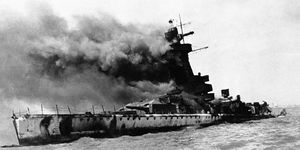

On 5 July 1946, the National Council initiated Operation Destroy Everything, known in Creeperian Spanish as Destruye Todo. The operation was a joint aerial and artillery bombardment of Romerist controlled parts of San Salvador. Like Operation Torch, Operation Destroy Everything utilized the Miguelist Air Force's 15th, 27th, and 28th Air Force Wings. Taking off from airbases in Zapatista, the Air Force Wings bombarded San Salvador for three days. Strategic bombers targetted factories and dockyards, tactical bombers targetted churches, hospitals, and barracks, while fighters fended off Romerist Air Force fighters returning fire. Miguelist anti-aircraft fire was also utilized from the shores of Lake Zapatista.
Hours after the aerial bombardment began, Miguelist artillery began attacking. As the artillery was firing upon the Romerist positions, the 1st and 11th Miguelist Armies launched an attack on the nearly encircled 2nd Romerist Army, eventually cutting it off on land from Romerist reinforcements, however, the 16th Romerist Flotilla retained control of Lake San Salvador, ensuring that the 2nd Army always had supplies and reinforcements.
On 6 July 1946, during an artillery bombardment of San Salvador, a stray artillery shell missed its target of a dockyard in San Salvador by miles and, by chance, hit the 16th Flotilla cruiser CLI La'Victoria directly in the bridge. The impact with the bridge pushed the ship to her starboard side at a 35º angle, dumping many seamen into the sea and giving the ship a list to starboard which eventually stabalized at 26º due to all the coal and ammunition pushed to the starboard side. The list caused several boilers to explode. The reason they exploded is still unclear, but the explosions caused the ship to begin taking on water.
Nearby vessels, the 16th Flotilla destroyers DTI San Luís and DTI Jalisco sped to the CLI La'Victoria at full speed, since Emperor Romero I was onboard on his way to meet with Chief Field Marshal Alfonso Cabañeras Moreno. Of the 902 men on board, 674 survived and were evacuated. After three hours, the crew of the DTI San Luís found Romero I dead in the bridge. Among the other dead found were Rear Admiral Bautista Aznar Cabañas, commander of the CLI La'Victoria, and Colonel Antonio Fonseca Cabanellas of the 2nd Romerist Army. CLI La'Victoria was deemded a total loss by the officers of the DTI Jalisco and DTI San Luís and was scuttled to prevent it from being captured and torn apart for scrap by the Miguelists. The DTI San Luís relaid the news to Alfonso Cabañeras Moreno. He immediately ordered the tourture and execution of 1,946 Miguelist prisoners of war in retaliation. He declared himself Regent of the sixteen year old Emperor, Romero II, the son of Romero I.
Romerist morale was shattered by the news while Miguelist morale greatly improved. Cabañeras Moreno told his men that Romero I fell for them and that they now had to fall for him and take Miguel VII down with them. He rallied up the Romerist soldiers and lead a victory in the sea at the Battle of the Asambio River on 12 July and a land battle at the Battle of Metachague on 17 July.
Death of Miguel VII
Massacre of 1947
Burning of 1948
Operation Melon
Operation Watermelon

Romerist victory

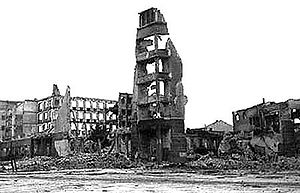
Maps
Casualties
Miguelists
Romerists
Aftermath
Significance
Commemoration
In popular culture
Books
Films and documentaries
Monuments
Poetry
Legal poetry:
- La'Guerra Final del Romeristo
- La'Lucha Santo por'Dios
- La'Vida deun Romeristo
- San Salvador es Nuestro
- Siempre Lucha por la'Patria
Illegal poetry:
See also
|
Participants |
Key aspects | ||||
|---|---|---|---|---|---|
|
|
|
Illegal drug trade
Government aspects
| |||
| Anti-Government Forces |
Government of Creeperopolis | Death Squads | |||
Former government program Linked to
|
Former paramilitaries Linked to | ||||
